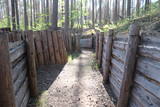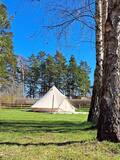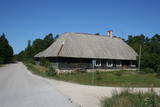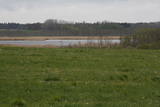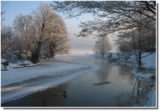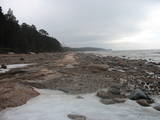| Нo | Название | Описание |
|---|---|---|
|
The first wooden Catholic church in Dagda was built in 1705, while the church that is seen today was built in the Baroque style during the latter half of the 18th century, the work financed by a local nobleman. Important interior elements include the altar, the pulpit, the organ, a monument to the Hilsen dynasty, etc. To the North of the church is historical Dagda itself, with typical red brick buildings from the early 20th century that are known as the former homes of Jewish merchants.
|
||
|
Ar Kara muzeja informatīvo atbalstu Garā kāpā pie Antiņiem ir rekonstruēta daļa latviešu strēlnieku nocietinājumu sistēmas. Aspkatāmas ierakumu pozīcijas un vairākas zemnīcas. Netālu atrodas bijusī un no dzelzsbetona veidotā medikamentu glabātuve. |
||
|
Atrodas Skolas ielā 12, Priekules pamatskolā. Tās krājumā ir plašs Priekules novadā iegūto vēsturisko liecību klāsts – sadzīves priekšmeti, darbarīki, dokumenti, padomju gados izsūtīto un represēto cilvēku atmiņu stāsti u.c. liecības, kā arī Priekules skolu attīstības vēsture. |
||
|
Хутор Elkas kalna saimniecība расположен на вершине живописной горы Элкас ‒ в том месте, где начинается Гауя. Травяные чаи, разные виды березового сока, варенье и другие полезные для здоровья лакомства из собранных на местных лугах и выращенных в саду растений. Также предлагаются природные мастерские и пикники под открытым небом. |
||
|
Место отдыха находится в историческом местечке «Кони» поселка Папе Южного Курземе. Место для ночлега - клеть, историческая постройка с тростниковой крышей, приспособленная для проживания поздней осенью / летом / ранней весной. 3 комнатки + небольшая передняя и кухня на двух этажах. Предназначена для 8 человек. Идеальное место для проведения творческих лагерей, пленэров, мастерских и других культурных мероприятий. Места для палаток, где можно принять до 80 человек. Двор «Микьяну» в сотрудничестве с группами по интересам «Клуба традиций Руцавы» предлагает по предварительной договоренности попробовать блюда местной традиционной кухни – «селедку на углях», белое масло с вареной картошкой, риезу (картофельную запеканку с луком и салом, а иногда и без мяса), уху и др. Предложение распространяется только на группы, по предварительной договоренности. |
||
|
Поселение расположено между улицей Пиладжу и левым берегом Силиньупе. В III–II тысячелетии до нашей эры здесь находилось поселение рыбаков и охотников, на месте которого установлен информационный памятный камень (скульпт. О. Скарайнис). Силиньупское поселение – наиболее известное место поселения древнего человека на территории Кемерского национального парка. Здесь найдены многие старинные предметы: осколки глиняной посуды, наконечники стрел, кусочки кремня и янтаря и др. Возможно, что на территории соседних частных домов находился могильник поселения. Небольшую часть находок можно увидеть в Лапмежциемском музее, остальные находятся в Латвийском Национальном историческом музее. |
||
|
Находится в историческом центре Лигатне (около пруда), в здании, где делалась первая лигатненская бумага. Латышская кухня: Строганов по-Видземски, приготовленная на гриле колкская салака, приготовленная на гриле свинина, аматская форель, картофельные блины с деревенской сметаной, домашние блины с варением, пиво и квас. Особое блюдо: Десерт «Лустузис». |
||
|
Bērzciema Lagūna ir atpūtas vieta zvejnieku ciematā Bērzciemā. Tiek piedāvātas divas teltis, katra ir 28 kvadrātmetrus liela, ar visām nepieciešamajām ērtībām, tostarp divguļamo gultu un atpūtas zonu. Viesu rīcībā ir arī pašapkalpošanās virtuve, āra duša un piknika vietas. Pēc iepriekšējas vienošanās vienā teltī maksimāli var izmitināt 4 personas. Piedāvājumā ir arī velosipēdu un SUP noma, telšu vietas un peldvieta jūrā. Glempings atrodas Enguras ezera Dabas parkā, kurā ir vairākas dabas takas, kā arī Engures ezera dabas taka ar savvaļas dzīvniekiem un putnu novērošanas torni un orhideju taka.
|
||
|
Находится в стороне от площади Куршу, ул. Э.Венденбаума, д. 1. Старейшая церковь города, сведения о которой сохранились с 1508 года. Первый храм на этом месте был построен из дерева. После неоднократных перестроек (последняя – в 1893 г. под руководством архитектора Лиепаи Пауля Макса Берчи) храм приобрел теперешний вид в неоготическом стиле с башней высотой около 60 м. Церковный интерьер славится одним из самых выдающихся шедевров времен барокко в Латвии – алтарем (резчик по дереву Николя Сефренс младший), который в 2012 году отметил свое 350-летие.Алтарь считается одной из самых выдающихся работ Восточной Европы того времени. Ретабло алтаря (5,8 x 9,7 м) известно тематическим циклом страданий Иисуса. В храме находится третий по величине орган Латвии, который построен по эскизам композитора и органиста Альфреда Калниньша. Церковь можно осмотреть изнутри и подняться на колокольню. |
||
|
В хозяйстве Teearu готовят различные блюда из рыбы, выловленной в озере Пейпус, ‒ особенно ценится приготовленный здесь маринованный копченый лещ. Также можно попробовать копченное традиционным способом мясо. Можно заказать услуги питания. |
||
|
В 50-х годах 19-го века здесь действовала школа, перенесенная из Жоцене. Находится возле церкви в Гипке. В 1938-м году Дундагский кооператив организовал здесь торговлю товарами первой необходимости. (Источник: Ройский ТИЦ) |
||
|
Один из красивейших яблоневых садов в Латвии (~ 10 га и 30 сортов яблонь), который разбит на склонах внушительного холма, с верхней части которого в ясную погоду можно увидеть воды Рижского морского залива. Особенно здесь красиво во время цветения яблонь. Предлагают яблоки и дегустации. |
||
|
Nature restricted area surrounds Tasu Lake and swampy shores of it in a narrow band. The territory was established to protect rare nesting and migratory birds. The territory is easily overseen from the narrow gravel roads all around the area not entering the actual protected area. Tasu Manor house is located to the South of nature restricted area.
|
||
|
This park is in an area which has not been affected much by humankind – sandstone cliffs, an undisturbed diversity of caves, other habitats, species and landscapes is the attractive aspect of this area. The Salaca River is one of the most important rivers in the Baltic Sea region for the spawning of salmon, and it is the second most popular river for water tourists in the Latvian region of Vidzeme. There are geological monuments which are very attractive to visitors – the Red cliffs, Skaņais Hill, the Neļķu cliff, the Velna (Devil’s) cave, etc. There are also cultural monuments such as the Livonian castle hill, the Vecsalaca baronial estate, the Livonian Museum, the Vantenberģi estate, the unique Salaca lamprey weirs, etc. Also in the park is one of the most popular tourist destinations in Northern Vidzeme – the Skaņākalna park, which has a dense network of footpaths. The Salaca is also popular among fishermen. This is part of the Northern Vidzeme Biosphere Reserve. |
||
|
Kalētu muižas bijušais medību dārzs. Muižas laikos šeit ierobežotās platībās turēja meža dzīvniekus, kuru medības bija populārs muižniecības izklaides veids. Parkā uzmeklējams piemiņas akmens Krievijas imperatoram Aleksandram III, kurš šeit nošāvis briedi (irsi). No Kalētiem Latvijas teritorijā „ienāca” staltbrieži, kurus medību vajadzībām 1848. g. atveda no Vācijas. Parkā izveidotas takas un atpūtas vietas. |
||
|
Klinšu smilšakmens ieži veidojušies, ūdens straumēm sanesot smilšainas, mālainas iežu daļiņas. Tās lēnām nogulsnējās un sablīvējās, topot par vareniem dabas veidojumiem! Līgatnes pagrabu alas savām rokām radījuši senie iedzīvotāji. Šī neparastā vieta ļāvusi daudzām paaudzēm izdzīvot, jo alās bija iespēja uzglabāt nepieciešamās pārtikas rezerves. Alām ir nemainīga temperatūra, kas padara tās par drošu pārtikas produktu un dzērienu glabātuvi. |
||
|
Старпиньупите – искусственно
выкопанное соединение между Каниерис и
Рижским заливом, где уровнем озера
сегодня управляет обновленная система
шлюзов. Хорошее место для наблюдения за
птицами в период весенней и осенней
миграции. Ориентир со стороны моря устье
реки Старпиньупите.
|
||
|
Gebaut am Ende des 18. Jh. im Stil des Frühklassizismus als der Besitz der Grafen von Mellin. Saaldekorationen vom künstlerischen Wert von K. V. Kalopka (1792) und Öfen (Ende des 19. Jh.). Ein Park. |
||
|
Селга к западу от Туи – важная территория для защиты малой чайки в период весенней миграции. Территория расположена напротив Салацгривского, Лимбажского, Саулкрастского и Царникавского края, ее площадь составляет 58 600 га.
|
||
|
Находится в центре Пиньки, на улице Ригас. Посвящен событиям 1919-го года, когда 22-го мая после почти двухмесячного бездействия бригада полковника Балодиса пошла в наступление на Ригу для освобождения столицы от большевиков. Поддержку бригаде Балодиса должны были оказать немецкий ландесвер и немецкая «Железная дивизия», а также отделение русского князя Ливена. Первый памятник был открыт президентом Латвии Карлисом Улманисом 23-го мая 1939-го года. В 1951-м году советская власть его уничтожила, а в 2003-м году была установлена копия памятника (скульптор Я. Бриедис, копия О. Скарайниса). |
||

